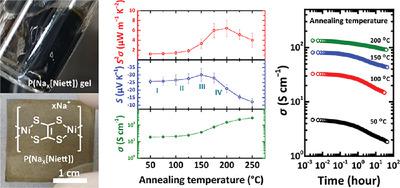当前位置:
X-MOL 学术
›
Adv. Electron. Mater.
›
论文详情
Our official English website, www.x-mol.net, welcomes your feedback! (Note: you will need to create a separate account there.)
Interplay Among Thermoelectric Properties, Atmospheric Stability, and Electronic Structures in Solution‐Deposited Thin Films of P(NaX[Niett])
Advanced Electronic Materials ( IF 6.2 ) Pub Date : 2020-01-29 , DOI: 10.1002/aelm.201901172 Sunbin Hwang 1, 2, 3, 4 , William J. Potscavage 3, 5 , Tae‐Wook Kim 6 , Chihaya Adachi 1, 2, 3, 5
Advanced Electronic Materials ( IF 6.2 ) Pub Date : 2020-01-29 , DOI: 10.1002/aelm.201901172 Sunbin Hwang 1, 2, 3, 4 , William J. Potscavage 3, 5 , Tae‐Wook Kim 6 , Chihaya Adachi 1, 2, 3, 5
Affiliation

|
Recent progress in organic thermoelectric generators has resulted in high performance through chemical control of the redox levels of organic semiconductors, but the scarcity of good candidates for soluble organic n‐type materials limits the use of π‐leg structures consisting of complementary elements of p‐ and n‐type materials because of unbalanced transport coefficients that lead to power losses. A sol–gel technique with oxidation is demonstrated to be effective for the fabrication of smooth films of poly(nickel 1,1,2,2‐ethenetetrathiolate), P(MX[Niett]), which is known as an insoluble material. By controlling the annealing temperature, a maximum n‐type power factor of 10.1 μW m−1 K−2 at 100 °C (Seebeck coefficient of −35.4 μV K−1 and electrical conductivity of 80.3 S cm−1) is demonstrated. Chemical and electronic structures of P(MX[Niett]) thin films are explored based on changes in optical absorption, ultraviolet, and X‐ray photoelectron spectroscopies to understand the origin of the high atmospheric stability. Analysis indicates that the stability arises from electronic states of the doped state that satisfy a balance with the redox potential of the air components and that stability under repeated redox reactions is an important factor for obtaining the n‐type organic thermoelectric materials that are highly stable in air.
中文翻译:

P(NaX [Niett])溶液沉积薄膜中的热电特性,大气稳定性和电子结构之间的相互作用
有机热电发生器的最新进展通过化学控制有机半导体的氧化还原水平实现了高性能,但是可溶有机n型材料的良好候选物的稀缺限制了由p-互补元素组成的π-腿结构的使用。和n型材料,因为传输系数不平衡会导致功率损耗。业已证明,采用氧化法的溶胶-凝胶技术可有效制造聚(1,2,2,2-亚乙基四硫醇镍)P(M X [Niett])的光滑膜,后者被称为不溶材料。通过控制退火温度,在100°C时的最大n型功率因数为10.1μWm -1 K -2(塞贝克系数为-35.4μVK -1导电率为80.3S cm -1)。基于光吸收,紫外线和X射线光电子能谱的变化,探索了P(M X [Niett])薄膜的化学和电子结构,以了解高大气稳定性的起源。分析表明,稳定性来自掺杂态的电子态,该态满足与空气成分的氧化还原电势的平衡,并且在重复的氧化还原反应下的稳定性是获得高稳定性的n型有机热电材料的重要因素。空气。
更新日期:2020-03-09
中文翻译:

P(NaX [Niett])溶液沉积薄膜中的热电特性,大气稳定性和电子结构之间的相互作用
有机热电发生器的最新进展通过化学控制有机半导体的氧化还原水平实现了高性能,但是可溶有机n型材料的良好候选物的稀缺限制了由p-互补元素组成的π-腿结构的使用。和n型材料,因为传输系数不平衡会导致功率损耗。业已证明,采用氧化法的溶胶-凝胶技术可有效制造聚(1,2,2,2-亚乙基四硫醇镍)P(M X [Niett])的光滑膜,后者被称为不溶材料。通过控制退火温度,在100°C时的最大n型功率因数为10.1μWm -1 K -2(塞贝克系数为-35.4μVK -1导电率为80.3S cm -1)。基于光吸收,紫外线和X射线光电子能谱的变化,探索了P(M X [Niett])薄膜的化学和电子结构,以了解高大气稳定性的起源。分析表明,稳定性来自掺杂态的电子态,该态满足与空气成分的氧化还原电势的平衡,并且在重复的氧化还原反应下的稳定性是获得高稳定性的n型有机热电材料的重要因素。空气。



























 京公网安备 11010802027423号
京公网安备 11010802027423号